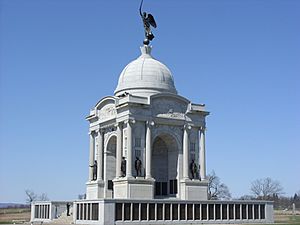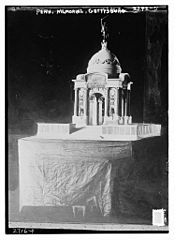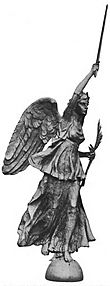Pennsylvania State Memorial, Gettysburg facts for kids
| Pennsylvania Monument | |
 |
|
| Coordinates | 39°48′27.32″N 77°14′6.55″W / 39.8075889°N 77.2351528°W |
|---|---|
| Location | Gettysburg National Military Park |
| Designer | W. Liance Cottrell (Architect) Samuel Murray (Sculptor) |
| Completion date | 1914 |
| Opening date | September 27, 1910 |
The Pennsylvania State Memorial is a huge monument in Gettysburg National Military Park. It honors the 34,530 soldiers from Pennsylvania who fought in the Battle of Gettysburg. This important battle happened from July 1 to 3, 1863, during the American Civil War. The memorial stands on Cemetery Ridge, which was the main battle line for the Union army on July 2, 1863. Finished in 1914, it is the biggest state monument on the Gettysburg Battlefield.
Contents
History of the Memorial
Back in the 1880s, a senator named Andrew G. Curtin had a big idea. He was Pennsylvania's governor during the Civil War. He wanted to build a "Pennsylvania Memorial Hall" on Little Round Top. This hall would be a place to keep special items and memories from all the Pennsylvania regiments that fought at Gettysburg.
His idea was even included in a state bill in 1889. But Governor James A. Beaver decided not to approve it.
Building the Monument
Eighteen years later, in 1907, the Pennsylvania government set aside $150,000 to build a state memorial. In February 1909, they announced where it would be built. A contest was held to pick the best design. A team won: W. Liance Cottrell, an architect from New York, and Samuel Murray, a sculptor from Philadelphia. They planned for the building to be ready by July 1, 1910.
Materials for the memorial were brought by train to a nearby station. This was because the road next to the memorial wasn't built until 1911.
Finishing Touches
The memorial wasn't quite finished when it was first dedicated on September 27, 1910. They had run out of money! So, in 1911, the state approved another $40,000. The new goal was to finish it by July 1, 1913. This date was special because it was the 50th anniversary of the battle.
The statues of important people were put in place in April 1913. The memorial was dedicated again on July 4, 1913. Finally, in 1914, a bronze plaque with the names of 945 more Pennsylvania veterans was added. This completed the memorial.
What the Memorial Looks Like
The memorial stands on a large, square granite base. This base is 100 feet on each side. On its outside, you can see bronze plaques. These plaques list the names of all 34,530 Pennsylvania soldiers who fought in the battle.
On top of this base is the main part of the memorial, called the pavilion. It's made of granite and has four corner towers. These towers are connected by arches, forming a four-sided triumphal arch. Columns stand at the corners and next to the arches. These columns create spaces for eight statues of important people.
Inside and Out
The pavilion is topped with a granite dome. Between the top wall and the dome, there's a viewing deck. You can reach it by a spiral staircase inside one of the towers. Below the pavilion, there's a vaulted cellar. The main entrance is on the west side, where wide steps lead up to the base. Smaller steps go under each arch into the central hall of the pavilion.
A bronze statue of a figure called the Goddess of Victory and Peace sits on top of the dome. She holds a sword in one hand and a palm branch in the other. The palm branch is a sign of victory through peace. What's really cool is that the bronze used for this goddess came from melted-down cannons! This reminds us of the idea to turn "swords into plowshares," meaning to use tools of war for peaceful purposes.
Above the arches, you'll see carvings of winged goddesses. Above the main ledge, there are panels with carvings showing different parts of the army: Artillery, Cavalry, Infantry, and Signal Corps. Larger-than-life bronze statues of famous Civil War figures, like President Abraham Lincoln, stand next to the arches. Above them are carved shields and wreaths. The names of other important people from the battle are carved on the memorial's walls, both inside and out.
Sculptures at the Memorial
- Goddess of Victory and Peace (1909–10) by Samuel Murray. This huge statue sits on top of the dome. It is 21 feet tall and weighs 7,500 pounds.
Portrait Statues
These are statues of important people from the Civil War:
- President Abraham Lincoln (1911–1913) by J. Otto Schweizer, on the west side.
- Governor Andrew Curtin (1911–1913) by William Clark Noble, on the west side.
- General George Meade (1911–1913) by Lee Lawrie, on the north side.
- General John F. Reynolds (1911–1913) by Lee Lawrie, on the north side.
- General Winfield Scott Hancock (1911–1913) by Cyrus Edwin Dallin, on the east side.
- General David McMurtrie Gregg (1911–1913) by J. Otto Schweizer, on the east side.
- General Alfred Pleasonton (1911–1913) by J. Otto Schweizer, on the south side.
- General David B. Birney (1911–1913) by Lee Lawrie, on the south side.
Architectural Carvings
These are carvings that are part of the building's design:
- Four white marble panels with carvings:
- Artillery (1909–10) by Samuel Murray, on the north side.
- Cavalry (1909–10) by Samuel Murray, on the south side.
- Infantry (1909–10) by Samuel Murray, on the west side. This one shows the Pennsylvania Bucktails at McPherson Farm.
- Signal Corps (1909–10) by Samuel Murray, on the east side.
- Attendants to Victory, eight white marble goddess figures (1909–10) by Samuel Murray. There are two above each arch.
- Eight white marble Shield & Laurel Wreath carvings (1909–10) by Samuel Murray. One is above each portrait statue.
Plaques for Regiments
Around the outside wall of the memorial, there are 75 bronze plaques. These plaques honor the different Pennsylvania military units that fought in the war.
Taking Care of the Memorial
Over the years, the Pennsylvania State Memorial has needed some care. In 1921, the dome was made stronger with steel and sealed to protect it. In 1929, the monument's copper parts were fixed, and any old wood was replaced. A nearby building for visitors was finished in 1933. This was one of the first buildings designed in a special style for Gettysburg National Military Park.
Images for kids































































































